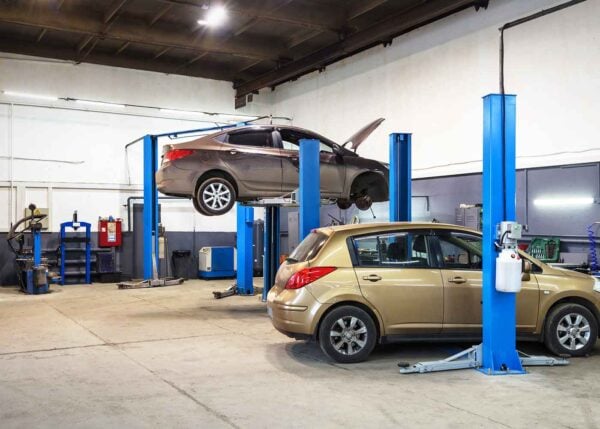01. Asbestos Use in Automobiles
How Was Asbestos Used in Automobiles?
Asbestos was frequently used in the automobile industry in various vehicle components. The mineral was commonly used in these settings from the early 1900s to the 1980s.
Vehicle parts contained asbestos for durability, insulation, heat resistance and fireproofing. Many automotive parts face high friction or intense heat from the engine. Asbestos helped make these parts longer-lasting and more fire-resistant. It was especially common in brake parts, clutches and other high-friction car parts.
However, asbestos-containing car parts can be easily damaged through normal wear and tear. They often need replacement or servicing, which can disturb asbestos fibers.
As a result, automobile mechanics, technicians and other automotive workers were susceptible to asbestos exposure. This includes car, motorcycle and truck enthusiasts, particularly those working with car products produced before 1980.
Repair work of any kind, both personal or occupational, conducted on asbestos parts can lead to asbestos exposure.
Today asbestos is rarely used in automotive parts in the United States. However, workers are still at risk of exposure. Asbestos fibers in older parts may become airborne during service, removal or restoration. Inhaling these fibers poses a health risk to current automotive workers.
02. Notable Automotive Manufacturers
Notable Auto Companies That Used Asbestos
Many automotive companies used asbestos components. This includes well-known brands such as Borg-Warner Automotive Inc., Ford, General Motors and Chrysler. Some companies manufactured these parts in-house. Other companies may have purchased them from secondary asbestos companies.
Any company that used or manufactured asbestos parts may have exposed auto workers and consumers to the mineral.
Borg-Warner Automotive Inc.
Borg-Warner Automotive Inc. was formed in 1928. The company began as a partnership between several preexisting automotive companies:
- Borg & Beck
- Marvel-Schebler
- Mechanics Universal Joint
- Warner Gear
The company produced many automotive components, including brake linings, transmissions, clutch linings and other friction parts. Many of these products contained asbestos.
Borg-Warner clutch linings contained asbestos from 1928 to 1980. The company’s brake linings included asbestos from 1971 to 1975.
Other products may also have contained asbestos between 1928 and the 1980s, when the company stopped using asbestos in its products.
Borg-Warner’s decades of asbestos use led to rising litigation costs for the company. Successful asbestos lawsuits against Borg-Warner are paid from the company’s own funds. In 2016, the company set aside $441 million to cover current and future asbestos costs.
Advance Auto Parts
Advance Auto Parts was founded in 1932 as a three-store chain of general supply stores called Advance Stores. It sold household items and automotive parts and provided oil changes.
Advance Stores carried several brands of asbestos-containing automotive equipment, including Ford and General Motors brands.
Ford Motor Company used asbestos brake linings beginning in 1909. In 1920, General Motors also began using asbestos in its products.
By the early 1940s, Advance Stores had 21 locations. The company continued to expand across the eastern U.S. In 1978, Advance Stores dropped its household products and expanded its automotive offerings, officially becoming Advance Auto Parts.
Asbestos-containing products sold by Advance Auto Parts included:
- Brake linings
- Brake pads
- Brakes
- Clutch parts
By the 1980s, many brands carried by Advance Auto Parts stopped using asbestos in products. However, some companies continued using the carcinogen. For example, British automobile manufacturer Ferodo used asbestos in brake linings until 1998. Advance Auto Parts carried Ferodo products, potentially exposing its customers.
Advance Auto Parts has been named in many asbestos lawsuits for its role in exposing individuals to asbestos. It continues to pay asbestos claims from its own funds.
National Automotive Parts Association (NAPA)
A group of independent automotive part sellers started NAPA in 1925. Currently, there are 57 distribution centers and 6,000 retail shops across the United States. NAPA sold automotive parts, many of which contained asbestos.
NAPA was a leading seller of automotive parts during the height of asbestos use and may have exposed thousands of people to the mineral.
Some products sold by NAPA that contained asbestos included:
- Brake lining and pads
- Clutch linings
- Gaskets
- Heat shields
- Insulation
- Spark plugs
While NAPA no longer uses asbestos in any of its products, older vehicles and parts may still contain asbestos products. NAPA stores may also sell imported parts containing asbestos. Auto mechanics, hobbyists and others who work on cars and other automobiles may still be at risk of exposure.
Other Companies That Caused Exposure
A number of other companies manufactured or used asbestos-containing parts for cars, trains and other forms of transportation. This wide use of asbestos materials put many people at risk of exposure.
03. Who Is at Risk?
Who Is at Risk of Exposure From Automobiles?
Individuals who worked with or near automobiles built before 1980 may have been exposed to asbestos. When asbestos-containing products are disturbed, fibers may become airborne and cause asbestos-related diseases, such as mesothelioma.
Although asbestos use has been regulated, workers can still be exposed when working with older vehicles. Anyone with occupational asbestos exposure from automobiles is at risk of developing asbestos cancer.
There are many different ways employees in the automotive industry have been exposed to asbestos. For example, if involved with the manufacturing process, workers may have had to cut and trim pieces of asbestos insulation to fit the car body.
Auto mechanics and technicians may have been exposed when replacing old parts, repairing components that have faced heavy wear and tear and disposing of old equipment. Researchers in a 2018 study from the Nelson Institute for Environmental Studies at the University of Wisconsin-Madison found auto mechanics working on brakes are at increased risk for mesothelioma and other asbestos-related diseases when compared to the general public.
Auto technicians and mechanics were not the only people at risk of asbestos exposure. When large amounts of asbestos are disturbed, anyone in the vicinity may be exposed. This includes anyone inside auto shops or vehicle plants.
Exposure may also extend to family members, through secondary asbestos exposure. For example, workers coming home with asbestos on their clothing may expose their loved ones to the fibers.
Asbestos exposure can pose a significant health risk, even if it is infrequent. Exposure can lead to asbestos diseases, such as mesothelioma, asbestosis and asbestos lung cancer. To prevent these diseases, individuals should avoid asbestos exposure as much as possible.
04. Asbestos Lawsuits
Asbestos Lawsuits and Compensation
Automotive workers who have developed an asbestos disease from occupational exposure may be eligible for financial compensation. If exposure can be tied to specific products or companies, individuals may be able to file for compensation from those parties.
There are three main sources of mesothelioma compensation:
- Asbestos trusts
- Verdicts from mesothelioma lawsuits
- Mesothelioma settlements
Each compensation option has specific eligibility requirements. A mesothelioma attorney can help diagnosed individuals and their loved ones determine which option is best for them.
05. Preventing Asbestos Exposure
Preventing Asbestos Exposure From Automobiles
Several U.S agencies and state governments have established asbestos regulations to mitigate exposure. While general U.S. Environmental Protection Agency (EPA) and Occupational Safety and Health Administration (OSHA) regulations apply to automotive professionals, there are also specific guidelines for these workers.
Asbestos handling recommendations for automobile shops differ based on the frequency of asbestos exposure and type of work.
OSHA-Recommended Automobile Shop Asbestos Precautions
OSHA recommends automotive workers use one of the following cleaning methods, depending on how many pairs of brakes or clutches they work on per week:
- Low Pressure/Wet Cleaning Method: A wetting agent is used to flood the brake or clutch assembly. The fluid is then caught in a catch basin. All clutch and brake components are wetted and cleaned thoroughly before handling. Basin contents should be disposed of according to OSHA regulations.
- Negative-Pressure Enclosure/HEPA Vacuum System Method: A secured enclosure is fitted tightly around a brake assembly or clutch assembly to hold the entire component. The enclosure is kept under pressure using a HEPA-filtered vacuum. This prevents the release of asbestos fibers into the worker’s breathing zone.
- Wet Wipe Method: A spray bottle or other water distribution mechanism is used to apply water to the part with a low-pressure spray. The assembly components are then wiped down with a cloth. The cloth should be contained, labeled and disposed of according to OSHA regulations.
These work practices can help prevent asbestos exposure in automotive workers. Researchers in a 2004 study found “the cumulative exposures of brake mechanics who worked in garages with dust-control measures in place were substantially lower.”
The OSHA recommendations above are typically used by trained automotive professionals. Car enthusiasts should not attempt to replicate these methods as a way to “safely” handle asbestos parts.
If at-home mechanics are working with older cars or suspect the presence of asbestos in car parts, they should take precautions to limit the potential of exposure as much as possible. To help prevent asbestos exposure, home mechanics should:
- Use the proper tools and/or wear protective gear. Incorrectly handling asbestos-containing products, such as grinding on an automotive part, could release asbestos fibers into the air. For example, machinery with a HEPA filter can help collect asbestos dust.
- Understand the car parts being used. Pay attention to the brand and manufacture date of parts. When working with newer parts, try to use pre-ground, ready-to-install products.
- Keep the worksite contained and clean. As much as possible, keep others away from the work area. Leave any equipment and clothing contained in the work area to avoid bringing asbestos dust into the home.
- Use the wet method to clean up the space. Vacuuming or sweeping could stir asbestos dust into the air. If you believe you have worked with asbestos parts, spray down areas with water and wipe them clean.
To avoid asbestos exposure, home mechanics and those with vintage or classic cars may choose to get work done at a professional car shop. These shops are best equipped to protect workers from asbestos exposure. The only way to safely avoid exposure is to avoid handling asbestos at all.
06. Common Questions
Common Questions About Asbestos in Automobiles
-
When did asbestos stop being used in brake pads?
- Most American automotive and automotive part manufacturers stopped using asbestos in the early 1990s. But aftermarket parts, older cars and car parts and parts imported from other countries may still contain asbestos and asbestos products.
-
Was asbestos used in car interiors?
- Asbestos use was not common in car interiors. Most asbestos in cars and other vehicles was found in parts for engines and other internal areas. However, asbestos may have been used in some car insulation or body parts.




